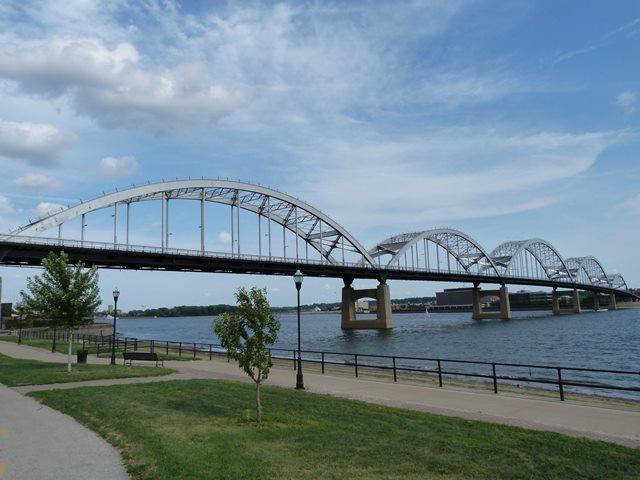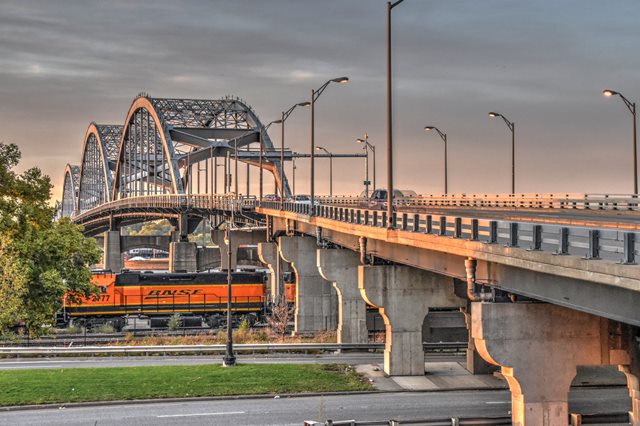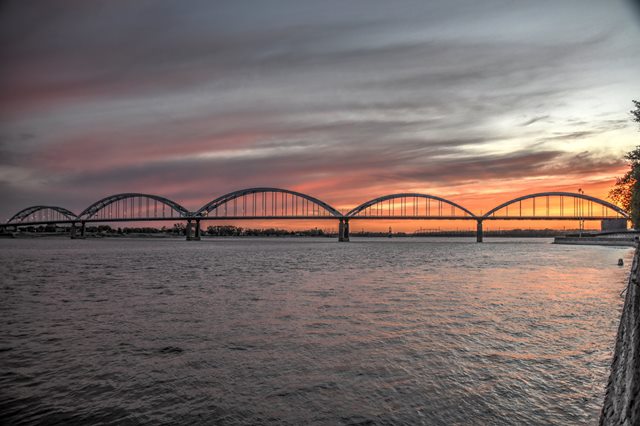We Recommend:
Bach Steel - Experts at historic truss bridge restoration.
Centennial Bridge
Rock Island Centennial Bridge

Primary Photographer(s): Nathan Holth
Bridge Documented: August 11, 2013 and October 15, 2021
US-67 Over Mississippi River and Various Streets and Railroads
Davenport and Rock Island: Scott County, Iowa and Rock Island County, Illinois: United States
Metal Tied Solid Ribbed Through Arch, Fixed and Approach Spans: Metal Stringer (Multi-Beam), Fixed
1940 By Builder/Contractor: American Bridge Company of New York, New York and Engineer/Design: Ash, Howard, Needles, and Tammen of New York, New York
2005
538.0 Feet (164 Meters)
3,853.2 Feet (1174.5 Meters)
46 Feet (14.02 Meters)
5 Main Span(s) and 24 Approach Span(s)
47020

View Information About HSR Ratings
Bridge Documentation
This impressive and distinctive landmark bridge was the first tied arch bridge to cross the Mississippi River. Many tied arch bridges only have a single main span, therefore this bridge is unusual among tied arch bridges because it has five spans. From north to south there are two 395 foot arch spans, two 538 foot arch spans, and one 395 foot arch span. The bridge also features a series of steel stringer approach spans. The northern (Iowa) approach is quite a bit longer. This bridge was designed by the firm Howard, Needles, Tammen, and Bergendoff. However, one of this firm's employees, Ned L. Ashton played a major role in the design of this bridge and is considered a noteworthy bridge engineer in Iowa history.
This bridge was originally a toll bridge when built. Tolls were apparently collected right in the middle of the bridge. Today, only the canopy that was built over the toll booths remains today. The five arches of this bridge are reportedly used to symbolize the five largest cities in the "Quad Cities" area with the largest two spans representing specifically the two largest cities which are Davenport and Rock Island, and which this bridge also connects. This bridge was originally going to be named the Galbraith Bridge after Robert Galbraith, the Rock Island mayor at the time. The official name of the bridge is the Rock Island Centennial Bridge.
Couse and Saunders of Detroit, Michigan was the contractor for the original concrete deck. This bridge was rehabilitated in 1996 and again in 2005.
In 2005, the bridge was given by the city of Rock Island to the Illinois Department of Transportation. It is hoped that IDOT will maintain and preserve this historic bridge. Currently in good condition, this is a rare historic bridge and a symbol for the area. It does not deserve to have its maintenance deferred and later be demolished and replaced like many of the bridges that IDOT is responsible for.
View Archived National Bridge Inventory Report - Has Additional Details and Evaluation
View Historic American Engineering Record (HAER) Documentation For This Bridge
HAER Data Pages, PDF
View Historical Articles About This Bridge


Information and Findings From Iowa's Historic Bridge InventoryDiscussion of Bridge Of the myriad bridges crossing the wide murky Mississippi river, the Centennial Bridge, connecting Davenport, Iowa, and Rock Island, Illinois, claims the distinction of being the first tie-arch form bridge across the Mississippi River. Furthermore, the project's design, construction, and financial backing define its significance on several distinct levels. Approval by the commission of the bridge design drawn up by the Kansas City engineering firm of Howard, Needles, Tammen, and Bergendoff was finalized in late winter of 1939. In April the commission let the foundation contract to McCarthy Improvement Company of Davenport, Iowa. Construction began the same month and McCarthy was fortunate to discover, during the pier-building process, that individual piers could be founded on solid bedrock, either limestone or blue shale rock. Progressing rapidly, American finished its work early in 1940 and the bridge officially opened for traffic on 21 July 1940. Since its construction, the Centennial Bridge's only major alteration of note is that it currently operates as a free crossing instead of a toll bridge. Barring this planned conversion, the Mississippi River bridge carries heavy traffic while retaining an exceptionally high degree of structural and historical integrity. One of the primary designers working for Howard, Needles, Tammen, and Bergendoff of Kansas City, Edward Ashton of Iowa City, was responsible of many of Centennial Bridge's unique attributes. This structure combined Ashton's inherent thriftiness with his vision of simplistic beauty. The clean lines and lack of ornamentation of the tied arch configuration proved to be both cost efficient and visually striking. As far as aesthetics was concerned, Ashton particularly admired the view of the trusses as one approached the main spans. The simple massiveness of the structure makes a strong statement about how Ashton felt bridges should appear. The Centennial Bridge is a significant Iowa highway-related resource for several reasons. The structure is historically important as in important crossing of a major Midwestern river. The Centennial Bridge is technologically significant as the first tied-arch span across the Mississippi River--a nationally important example of this inherently long-span design. And, considered by Ashton to be the best bridge he had ever designed, this gracefully proportioned structure is significant for its association with one of Iowa's most influential engineers [adapted from Crow-Dolby 1992]. Bridge Considered Historic By Survey: Yes |
This bridge is tagged with the following special condition(s): Unorganized Photos
![]()
Photo Galleries and Videos: Centennial Bridge
Bridge Photo-Documentation
Original / Full Size PhotosA collection of overview and detail photos. This gallery offers photos in the highest available resolution and file size in a touch-friendly popup viewer.
Alternatively, Browse Without Using Viewer
![]()
Bridge Photo-Documentation
Mobile Optimized PhotosA collection of overview and detail photos. This gallery features data-friendly, fast-loading photos in a touch-friendly popup viewer.
Alternatively, Browse Without Using Viewer
![]()
Additional Unorganized Photos
Original / Full Size PhotosA supplemental collection of photos that are from additional visit(s) to the bridge and have not been organized or captioned. This gallery offers photos in the highest available resolution and file size in a touch-friendly popup viewer.
Alternatively, Browse Without Using Viewer
![]()
Additional Unorganized Photos
Mobile Optimized PhotosA supplemental collection of photos that are from additional visit(s) to the bridge and have not been organized or captioned. This gallery features data-friendly, fast-loading photos in a touch-friendly popup viewer.
Alternatively, Browse Without Using Viewer
![]()
Maps and Links: Centennial Bridge
Coordinates (Latitude, Longitude):
Search For Additional Bridge Listings:
Bridgehunter.com: View listed bridges within 0.5 miles (0.8 kilometers) of this bridge.
Bridgehunter.com: View listed bridges within 10 miles (16 kilometers) of this bridge.
Additional Maps:
Google Streetview (If Available)
GeoHack (Additional Links and Coordinates)
Apple Maps (Via DuckDuckGo Search)
Apple Maps (Apple devices only)
Android: Open Location In Your Map or GPS App
Flickr Gallery (Find Nearby Photos)
Wikimedia Commons (Find Nearby Photos)
Directions Via Sygic For Android
Directions Via Sygic For iOS and Android Dolphin Browser
USGS National Map (United States Only)
Historical USGS Topo Maps (United States Only)
Historic Aerials (United States Only)
CalTopo Maps (United States Only)

